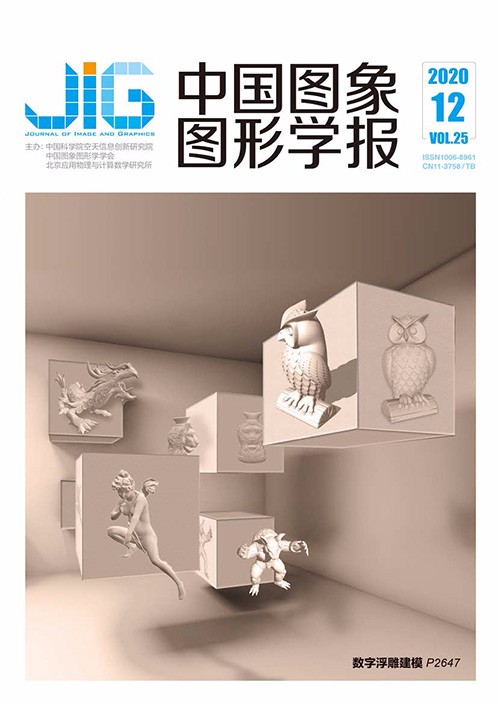
结构特征下的可撤销人脸识别
摘 要
目的 相对于其他生物特征识别技术,人脸识别具有非接触、不易察觉和易于推广等特点,在公共安全和日常生活中得到广泛应用。在移动互联网时代,云端人脸识别可以有效地提高识别精度,但是需要将大量的人脸数据上传到第三方服务器。由于人的面部特征是唯一的,一旦数据库泄露就会面临模板攻击和假冒攻击等安全威胁。为了保证人脸识别系统的安全性并提高其识别率,本文提出一种融合人脸结构特征的可撤销人脸识别算法。方法 首先,对原始人脸图像提取结构特征作为虚部分量,与原始人脸图像联合构建复数矩阵并通过随机二值矩阵进行置乱操作。然后,使用2维主成分分析方法将置乱的复数矩阵映射到新的特征空间。最后,采用基于曼哈顿距离的最近邻分类器计算识别率。结果 在4个不同人脸数据库上的实验结果表明,原始人脸图像和结构特征图像经过随机二值矩阵置乱后,人眼无法察觉出有用的信息且可以重新生成,而且融合方差特征后,在GT (Georgia Tech)、NIR (Near Infrared)、VIS (Visible Light)和YMU (YouTuBe Makeup)人脸数据库上,平均人脸识别率分别提高了4.9%、2.25%、2.25%和1.98%,且平均测试时间均在1.0 ms之内,表明该算法实时性强,能够满足实际应用场景的需求。结论 本文算法可在不影响识别率的情况下保证系统的安全性,满足可撤销性。同时,融合结构特征丰富了人脸信息的表征,提高了人脸识别系统的识别率。
关键词
Cancelable face recognition with fusion of structural features
Sun Haohao1, Shao Zhuhong1, Shang Yuanyuan1, Chen Bin2, Zhao Xiaoxu1(1.College of Information Engineering, Capital Normal University, Beijing 100048, China;2.College of Mathematics Physics and Information Engineering, Jiaxing 314001, China) Abstract
Objective Along with the wide usage of various digital image processing hardware and software and the continuous advancements in the field of computer vision, biometric recognition has been introduced to solve identification problems in people's daily lives and has been applied in the fields of finance, education, healthcare, and social security, among others. Compared with iris, palm print, and other biometric recognition technologies, face recognition has received the most attention due to its special characteristics (e.g., on-contact, imperceptible, and easy to promote). Given the wide usage of mobile Internet, cloud face recognition can achieve high recognition accuracy requires a large amount of face data to be uploaded to a third-party server. On the one hand, face images may reflect one's private information, such as gender, age, and health status. On the other hand, given that each person has unique facial features, hacking into face image databases may expose people to threats, including template and fake attacks. Therefore, how to boost the privacy and security of face images has become a core issue in the field of biometric recognition. Among the available biometric template protection methods, the transform-based method can simultaneously satisfy multiple criteria of biometric template protection and is presently considered the most typical cancelable biometric algorithm. The protected biometric template is obtained via anon-invertible transformation of the original biometric that is saved in a database. When this biometric template is attacked or threatened, a new feature template can be reissued to replace the previous template by modifying the external factors. To guarantee the security of the face recognition system and improve its recognition rate, this paper investigates a cancelable face recognition algorithm that integrates the structural features of the human face. Method First, structural features are extracted from the original face image by using its gradient, local binary pattern, and local variance. By taking the original face images as real components and the extracted structural features as imaginary components, a complex matrix is built to represent the face image. To render the original face images and contour of their structural features invisible, the complex matrix is permuted by multiplying it by a random binary matrix. Afterward, complex 2D principal component analysis (C2DPCA) is performed to project a random permuted complex matrix into a new feature space. The 2DPCA result for the scrambled complex face matrix is theoretically deduced and verified to be the result of original complex face matrix 2DPCA multiplied by a random binary matrix. The resulting value does not change after scrambling given that only the row of the original 2DPCA is scrambled in the process. The nearest neighbor classifier based on Manhattan distance is then employed to calculate the recognition rate, that is, the distance between the tested face images and all training samples, and the training sample category that corresponds to the minimum distance is taken as the category. Result The experimental results obtained for the four face databases reveal that after scrambling the original face and structural feature images by using a random binary matrix, the human eye cannot detect useful information, and the scrambled results can be regenerated. Therefore, scrambling the random binary matrix can ensure the security of the proposed algorithm. Compared with three other algorithms, the fusion of a structural feature can effectively improve the recognition rate. Among the three structural features considered in this work, the variance feature obtains the highest recognition rate, which has increased by 4.9% on the Georgia Tech(GT) database, 2.25% on the Near Infrared(NIR) database, 2.25% on the Visible Light(VIS) database, and 1.98% on the YouTube MakeupYMU database. The employed random binary matrix does not affect the recognition rate, that is, the recognition rates of each database are the same before and after random scrambling. Given that the introduced random matrix is binary, the values do not change after random scrambling. The average testing time for the four face databases is within 1 millisecond. Conclusion A combination of the original face image with the structural features of the human face enriches the representation ability of face image information and helps improve facial recognition rate. A random permutation operation can also protect the privacy of the original face image. When the biometric template is leaked, resetting position 1 in the random binary matrix will re-scramble the complex face matrix and generate a new biometric template. The proposed algorithm also shows an excellent real-time performance and can meet the demands of practical application scenarios.
Keywords
cancelable face recognition random binary matrix two-dimensional principal component analysis(2DPCA) face structural feature complex matrix
|



 中国图象图形学报 │ 京ICP备05080539号-4 │ 本系统由
中国图象图形学报 │ 京ICP备05080539号-4 │ 本系统由